FREEZING COLD OVER EUROPE
DUE TO THE POLAR VORTEX | 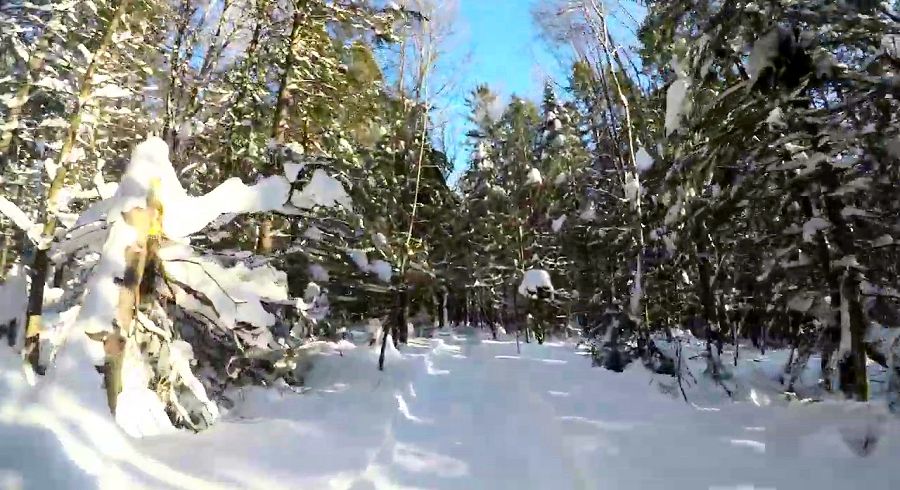 Icy cold is about to engulf Europe under the influence of the polar vortex, a swirling mass of cold air generally confined to the poles, thus extending its hold on France. From this Monday, January 8, Météo France forecasts negative maximum temperatures in the north and significant snowfall in the mountains, announcing an amplification of this phenomenon over the coming days, plunging temperatures into freezing depths. Icy cold is about to engulf Europe under the influence of the polar vortex, a swirling mass of cold air generally confined to the poles, thus extending its hold on France. From this Monday, January 8, Météo France forecasts negative maximum temperatures in the north and significant snowfall in the mountains, announcing an amplification of this phenomenon over the coming days, plunging temperatures into freezing depths.
To understand this meteorological change, it is appropriate to look at the "polar vortex", a term little used in everyday language, mainly reserved for meteorologists' jargon, designating a swirling mass of cold air, traditionally confined to the poles. This renowned vortex is set to move towards unusual latitudes over the coming days, causing temperatures to drop dramatically by around -10°C across France. This exceptional cold snap could mark the most frigidly intense day since 2018, affecting cities such as Paris, Nantes and Lille.
Between Saturday and Sunday, temperatures have already declined by 2 to 4°C across the country. Paris notably recorded a loss of 4 degrees in 24 hours, prompting the Île-de-France prefecture to trigger the Great Cold Plan. This phenomenon will not only spare the north of the country.
According to Météo France, this movement of polar cold towards France is a rare but natural phenomenon. The polar vortex, a depression of cold air located about 30 kilometers above the poles, is traditionally maintained by very fast circular winds, the "stratospheric jets of the polar night".
These powerful winds strengthen the jet stream when they move from west to east, and weaken it when they go in the opposite direction. By disrupting the jet stream, they propel cold air from the polar vortex towards unusual regions. The current, disturbed, oscillates towards mid-latitudes, trapping cold air in the troposphere, the atmospheric layer located between 8 and 12 kilometers above sea level.
It is precisely this phenomenon that will take place in the coming days in Europe, leading to a gradual and rapid decrease in temperatures.
Météo-France is forecasting a cold peak this Tuesday with temperatures felt around -10 degrees. The maximums will hardly exceed 10 degrees in Corsica, and will only reach 2 degrees for cities like Bordeaux or Tarbes. |
|
|
|
| Boby Dean for DayNewsWorld |
 |
THE ERUPTION OF THE FAGRADALSFJALL VOLCANO
IMMINENT PUTS ICELAND ON ALERT STATE |
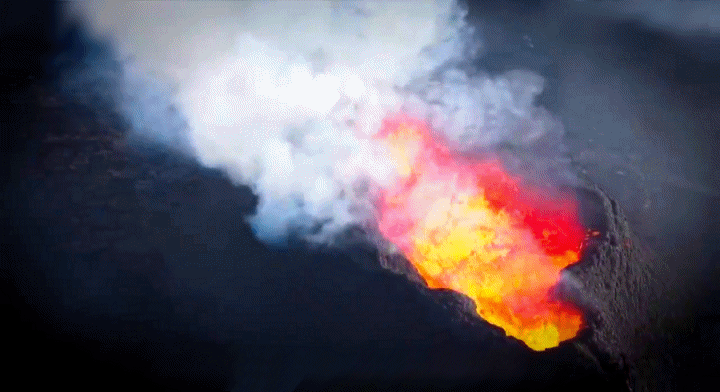
An imminent threat looms over Iceland with the possible eruption of the Fagradalsfjall volcano.
An intense series of earthquakes shook the Reykjanes Peninsula in southwest Iceland, starting on Friday, November 10, 2023. Hundreds of earthquakes were detected by regional seismometer networks and several were strong enough to be felt in Reykjavik, 50 kilometers away. A civil protection alert was triggered warning of the risk of a volcanic eruption – it would be the fourth since 2021.
Iceland straddling a collapsing ditch
Iceland sits majestically on the Mid-Atlantic Ridge, a place where the North American and Eurasian plates are gradually moving away from each other, at a rate of about 2 centimeters per year. In the depths of the Earth's mantle, where the rocks adopt the consistency of extremely rigid caramels, the plates agree to deform in an uninterrupted manner.
However, as they approach the surface, the rocks of the earth's crust reveal their cold and brittle nature: their extension only occurs at the cost of their rupture. The Reykjanes Peninsula forms the southwest tip of Iceland, where the Mid-Atlantic Rift emerges from the ocean. There, the Earth's crust responds to relentless tectonic forces by cracking every few centuries, giving rise to a collapse gap, commonly called a rift.
The last sequence of crustal rupture and eruptions dates back more than 800 years. Since then, the plates should have moved apart by about sixteen meters. Currently, Iceland is experiencing a new phase of rupture, marked by hundreds, if not thousands, of earthquakes, many strong enough to be felt in the southwest of the island. All these phenomena are caused by the intrusion of magma close to the surface.
Each earthquake and eruption releases some of the energy stored in these tectonic plates, and eventually, when all of this tension is completely released, the eruptions will end. Crustal ruptures are facilitated by the presence of magma, acting as a lubricant, a feature shared with other ocean ridges. Magma forms continuously at depth, and its density means it will rise.
Within the rigid and brittle crust, magma can only make its way by following existing fractures, if any. However, once it begins its ascent, it traces its path towards increasingly shallow areas, thus intensifying the risk of eruption.
In early November 2023, the Icelandic government declared a state of emergency in the area surrounding the Fagradalsfjall volcano, following a series of earthquakes, often warning indicators of a volcanic eruption.
On November 11, 2023, preventive measures were announced to mitigate the possible devastating effects of an impending eruption. The response plan by the authorities and the tourism industry was activated in response to recent developments, including the numerous earthquakes recorded in Reykjanes, as reported on the government website in English.
As part of these measures, the town of Grindavík, home to 4,000 inhabitants, was evacuated to ensure the safety of residents. The Icelandic Meteorological Office (IMO) expresses serious concerns about the possibility of large quantities of magma spreading underground, which could erupt in the region. Scientists are carefully monitoring the region's seismic activity.
“Since midnight on November 11, approximately 800 earthquakes have been recorded in the area where the magma intrusion is occurring. Although seismic activity has decreased slightly in recent hours, it remains high.
Most of the recent earthquakes occurred near Grindavík, where the southwest end of the magmatic dike intrusion is estimated to be present," the IMO said. At midday on November 11, the Office meteorologist published on Twitter a map of ground deformations in the region, described as "much higher than normal".
With around 30 active volcanoes over 100,000 square kilometers, Iceland strives to best manage the anticipation of volcano-related risks. In the case of Fagradalsfjall, the threat comes from underground magma that could soon emerge.
An imminent eruption with the release of magma
The possibility of an imminent eruption with the emergence of magma now concerns observers. Signs of this threat are manifested by a progressive deformation of the Earth's surface, signaling the intrusion of fresh magma into the crust. Over the past weekend, the situation has evolved dynamically. Parameters such as the size, number and location of earthquakes clearly indicate the filling of a crustal fracture with magma, at a depth of about 5 kilometers.
The magma persists in its intrusion, widening the ends of the fracture and creating a passage through the crust, thus forming a "dike" - a vein of rock infiltrated into a fissure - about 15 kilometers long. Although the magma has not yet reached the surface, ground movements and computer models suggest that a magma reservoir has built up within a kilometer of the surface.
Anticipation of an imminent eruption remains high, but monitoring teams will only be able to determine the precise time and location when they detect specific signals indicating magma movement. These signs could include a repetitive "buzzing" of volcanic tremors, announcing a possible eruption in the coming hours, or an increase in earthquakes at very shallow depths.
The results
Currently, the dike appears to extend directly beneath the town of Grindavik, a fishing community in southwest Iceland. If a surface eruption occurs, it could resemble those of 2021-2023 at Fagradalsfjall, with a fissure opening onto the earth, fountains of hot red molten rock, and lava flowing down the hillside from the site of the rash.
The potential threat will depend on the exact location of the start of the eruption and how far the lava has traveled. Fumes emanating from erupting magma, combined with the burning of peat and vegetation, could also create toxic air, depending on the speed of the eruptions and the direction of the winds.
In the event of an eruption in Grindavik, the consequences could be comparable to those of the Eldfell eruption in 1973, which buried part of the town of Heimaey.
This is why a preventive evacuation of the town, the nearby Svartsengi geothermal power plant, and the Blue Lagoon, one of Iceland's most popular tourist attractions, is currently underway.
|
|
|
|
| Simon Freeman for DayNewsWorld |
 |
NOBEL PRIZE IN MEDICINE TO PIONEERS OF MESSENGER RNA VACCINES
KATALIN KARIKO AND DREW WEISSMAN | 
The Nobel Prize in Medicine was awarded on Monday October 2 to Katalin Kariko from Hungary and Drew Weissman from the United States for their major breakthroughs in the field of messenger RNA vaccines, crucial in the fight against Covid-19.
The jury praised these two researchers “for their discoveries linked to alterations of the nucleic bases which made possible the development of effective mRNA vaccines against Covid-19”, when announcing the prize.
These winners have accelerated the development of these vaccines in the face of one of the greatest contemporary threats to human health.
This distinction is accompanied by a record financial reward of eleven million Swedish crowns (approximately 920,000 euros), establishing a new nominal high in the century-old history of the Nobel Prizes.
The Nobel Foundation increased the amount of this endowment in September thanks to a favorable financial situation.
In 2022, the Nobel Prize in Medicine was awarded to Svante Pääbo, a Swedish pioneer of paleogenomics, for his revolutionary work on the complete sequencing of the Neanderthal genome. He founded this discipline which explores ancestral DNA to shed light on contemporary genetics.
Messenger RNA is anything but “experimental”
The awarding of the 2023 Nobel Prize in Medicine vividly underlines that messenger RNA is anything but an “experimental” technology. By rewarding the work of Katalin Kariko and Drew Weissman on messenger RNA vaccines, the Academy is undertaking a long and laborious journey of discovery.
25 years ago, in 1997, Hungarian-American researcher Katalin Kariko presented her research on messenger RNA, known since the 1960s, to her new associate, Drew Weissman. At the time, his attempts did not bear fruit, costing him his position as a biochemist at the University of Philadelphia. For several years, despite laboratory changes, his research was unsuccessful: with each test, the RNA caused inflammation in the mice that the vaccine was supposed to protect.
It was only in 2005, after many years of trying, that Kariko and Weissman found success. The idea of modifying RNA so as not to alert the immune system turns out to be the key to this success, the foundation of vaccines as we know them today.
A long and laborious journey of discovery.
However, there is still a long way to go before this innovative technology is adopted by large pharmaceutical companies. Years after the publication of their research, it has attracted little interest from the giants of the pharmaceutical industry. Only Moderna (founded in 2010) and BioNTech (founded in 2008), two biotechnology companies, are interested in the work of the two researchers.
In 2013, Katalin Kariko chose BioNTech.
This is when collaborations with large companies begin: Pfizer in 2018, for the development of a flu vaccine; Sanofi in 2019 for treatment against cancer, as well as the Bill and Melinda Gates Foundation that same year...
Research into vaccines using RNA technology is then carried out on all fronts.
However, it is obviously during the Covid pandemic that these years of efforts bore fruit, with the development of the first messenger RNA vaccine for humans. This is no coincidence: Pfizer is already a partner of BioNTech, and the RNA solution seems to be the most promising for the American giant. For what ? Precisely because this technology, known for decades, has reached a point of maturity.
The first RNA vaccine in humans against rabies, tested in... 2013
The journey of Katalin Kariko and Drew Weissman summarizes this long and very long history of the development of modified RNA technology. Since its first use in the laboratory in 1984, hundreds of researchers have worked to develop an effective, and above all, stable solution. What characterizes this technological evolution is much more the obstacles overcome than its speed in reaching the market, as was the case with vaccines against Covid in 2020-2021.
Katalin Kariko's research in the late 1990s certainly propelled RNA forward, but it was not enough. Until the early 2000s, the fragility of modified RNA made its injection ineffective, because it was immediately destroyed.
The solution was to encapsulate it in lipids to prevent its degradation, and it was not until 2012 that this method became established in the scientific community. Again, numerous laboratory replications were required.
As for tests on human subjects, they are not recent. The first RNA vaccine tested on humans was a preventive treatment against rabies, tested in... 2013. Then until 2020, candidate vaccines against the Zika virus, against Ebola, or even H1N1 were used. subject of clinical trials on patients.
The emergency of the Covid pandemic has removed financial and administrative obstacles, while creating enormous demand for a vaccine. This allowed RNA-based treatment against Sars-CoV-2 to arrive earlier than others.
However, calling this vaccine an “experimental” solution is an offense to the winners of the 2023 Nobel Prize in Medicine, as well as to the multitude of researchers who have contributed to the maturation of this technology. |
|
|
|
| Simon Freeman for DayNewsWorld |
 |
A LIVING AND WRIGGING WORM
DISCOVERED IN THE BRAIN OF AN AUSTRALIAN WOMAN | 
A unique discovery. A worm has nested inside the brain of an Australian woman.
A roundworm, which commonly parasitizes snakes, has been discovered for the first time on a human, extracted "alive and writhing" from the brain of an Australian woman during surgery, Australian doctors announced Tuesday.
It was neurosurgeon Hari Priya Band who detected and removed the 8-centimeter worm, alive, from the brain of one of her patients.
Originally from southeast Australia, she was admitted at the end of January 2021 after suffering from abdominal pain, diarrhea then a dry cough, night sweats and fever.
A year later, this 64-year-old woman developed new symptoms: memory loss and depression.
These will then push her to return to Canberra hospital. After an MRI of the brain, an “abnormality requiring intervention” was revealed.
It was an Ophidascaris robertsi which, according to researchers, is a parasite of kangaroos and pythons in Australia. It parasitizes animals in other parts of the world, but has never before been detected in a human being.
“This is the first ever human case of Ophidascaris described in the world,” said infectious diseases specialist Dr. Sanjaya Senanayake.
“To our knowledge, this is also the very first case involving the brain of a mammalian species, human or otherwise,” he said.
Contamination via snake excrement
But then, how could such a parasite have infiltrated this patient's brain?
Living near a lake where there are many pythons, the patient used to walk there and collect herbs and plants.
Scientists believe the Australian was parasitized by edible plants, probably contaminated by larvae present in snake droppings. The parasite, whose "thread-like structure" appeared on brain scans, was later identified through DNA testing.
“It is never easy or desirable to be the first to be sick with anything in the world,” added Dr. Senanayake. “I cannot express enough our admiration for this woman, who showed patience and courage throughout this process.
According to Dr Senanayake, it is “likely that more cases will be identified in the future”. |
|
|
|
| Kelly Donaldson for DayNewsWorld |
 |
OWARDS THE ANTHROPOCENE A NEW GEOLOGICAL ERA TRIGGED BY HUMANITY ?
|

Since 2009, geologists have been working hard to gather evidence of the passage to a new geological epoch triggered by humanity.
Lake Crawford, near Toronto in Canada, has been recognized since Tuesday July 11 as a reference site for the beginning of the Anthropocene. This site was chosen this Tuesday evening by The Anthropocene Working Group (AWG) as the world reference for the beginning of the Anthropocene, a name proposed in 2002 by Paul Crutzen, Nobel Prize in Chemistry. This one square kilometer body of water was chosen because it concentrates many emblematic traces of human activities. For example, sediments laden with microplastics, ashes from the combustion of oil and coal, concentrations of pollen which testify to the evolution of vegetation and temperature changes, and even the fallout from explosions linked to nuclear tests.
Humans become a geological factor.
These elements are proof that a new chapter in the history of the Earth has opened. For this scientific working group, which started its work 14 years ago, and which chose this site, we have entered a new geological era , that of the anthropocene, from the Greek "anthropos" which means "human". . For the first time, a new period is created which considers human activities as a key factor which has as much importance as other extra-human parameters such as the activities of the sun. The Anthropocene is the age of the Earth in which humans became a geological factor.
For these scientists, we left the Holocene, that is to say the temperate period which started 12,000 years ago, at the end of the last glaciation and which allowed the development of the human species. Because a rupture has occurred: certain environmental and climatic balances have been broken under the influence of human activities.
Change of period, or not ? Steaming theory or not ?
For these scientists, the changes have been so rapid that they are bringing the planet into a period of unprecedented climate and environmental uncertainty. A period that deserves a new name. For Jan Zalasiewicz, chairman of the working group, it is urgent to recognize the Anthropocene. Because otherwise, we would give the impression that the conditions of the Holocene, the very ones that allowed us to flourish on Earth, are still there. However, "it is clear that this is no longer the case", he believes "Science is about establishing what is real and what is not. And the Anthropocene is very real."
But it's not won yet, because, officially, we are still in the Holocene. The International Commission on Stratigraphy, which validates geological designations, has strict rules, in particular that of identifying a primary marker that marks the change of period.
For the defenders of the Anthropocene, it could be, for example, the plutonium rejected by nuclear tests, because there is very little of it in the natural state. This would therefore start this new era around 1945 - 1950, a period which also corresponds to the acceleration of human consumption, of industrial production.
Other geologists, if they recognize that there was indeed a "break" in the last century, however, believe that all the criteria are not met to speak squarely of a "new era". Phil Gibbard, secretary of the ICS, prefers the term "geological event". "The conditions that caused the glaciations haven't changed, so we can expect the Holocene to be just another interglacial." In short, that the Holocene will end with the entry into a new ice age, similar to the one that preceded it, Man having been only a hiccup in the long history of the planet.
In 2002, Paul Crutzen, Nobel Prize in Chemistry, was the first to propose recording the end of the Holocene and the beginning of the Anthropocene.
For him, the issue was almost vital: it would make it possible to focus humanity on future challenges, to make it aware of the gravity of the situation, and to "change the paradigm in scientific thought".
|
|
|
|
| Pamela Newton for DayNewsWorld |
 |
THE INVESTIGATION INTO THE DISAPPEARANCE OF THE TITAN IS PROGRESSING AS THE SURFACE OF HUMAN REMAINS AND DEBRIS FROM THE SUBMERSIBLE
|
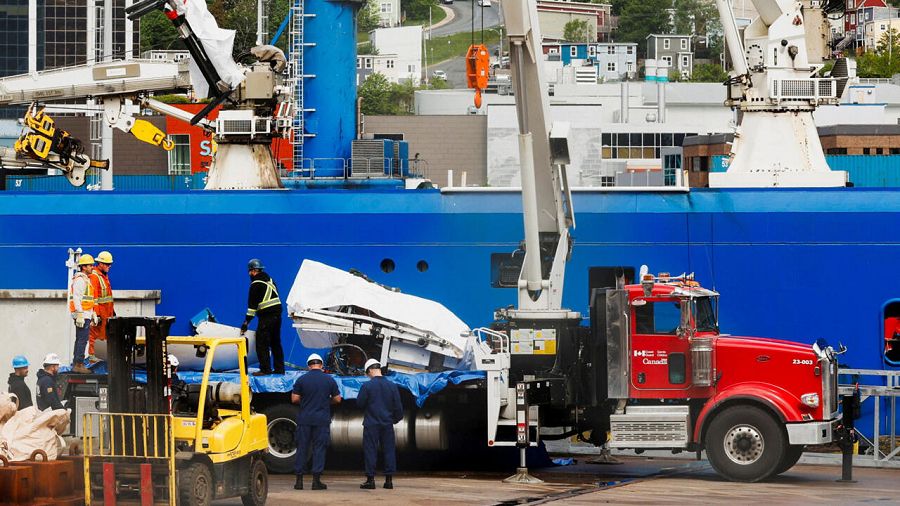
The wreck of the Titan submersible, which had tragically imploded during a Titanic wreck viewing expedition, continues to attract international interest. The US Coast Guard recently announced that it had recovered debris and evidence, including suspected human remains.
This crucial development is a major step forward in the investigation aimed at understanding the reasons for the tragedy and preventing such a disaster from happening again in the future.
The return of the wreckage of the Titan submersible to the port of St. John's, Newfoundland and Labrador marks a critical milestone in the ongoing investigation. The authorities are trying to determine the causes of the implosion which cost the lives of the five occupants of the submersible. The Canadian ship Horizon Arctic, which had participated in the search, transported the debris on board a remotely operated vehicle from the depths of the ocean to the coast.
Critical Evidence Recovered
In an official statement, Captain Jason Neubauer, Chief of the US Coast Guard, expresses his gratitude for the international support and inter-agency coordination that made it possible to recover this vital evidence under extreme conditions. The elements collected will provide essential information to the investigators of the international jurisdictions involved in the case. The need to understand the factors that led to this tragedy is paramount to avoiding similar incidents in the future.
An ongoing international investigation
The implosion of the submersible Titan, which occurred during its descent towards the wreck of the Titanic, resulted in the death of the five passengers and crew members. Canadian and American authorities are working closely together in this international investigation. The Transportation Safety Board of Canada (TSB) has already conducted preliminary interviews with those aboard the support vessel Polar Prince, which accompanied the Titan on its fatal dive.
Questions about the circumstances of the incident:
The company OceanGate, owner of the Titan, organized this eight-day expedition where clients paid $250,000 to visit the wreck of the Titanic. OceanGate CEO Stockton Rush piloted the submersible along with British billionaire Hamish Harding, French explorer Paul-Henry Nargeolet and Pakistani businessman Shahzada Dawood accompanied by his 19-year-old son, Suleman. Investigators are trying to understand the reasons for the implosion and the security measures taken during this expedition.
Manned submersibles are often used for scientific missions, site inspections and even tourist excursions, but this disappearance highlights the risks inherent in these explorations and raises questions about the safety measures put in place.
Features of the Titan submersible
The Titan is a submersible approximately 7 meters long, designed to take people to depths of up to 4,000 meters. It is propelled at a speed of approximately 3 knots, or 5.5 km/h. Unlike some submersibles that are tethered to a surface ship, the Titan appears to have operated independently on this expedition. According to information provided by the company OceanGate, owner of the submersible, the Titan is used for various activities such as site survey, data collection, film production and deep sea testing.
Communication and salvage challenges
The submersible would normally have been in acoustic communication with its surface vessel through a transponder and transceiver system. However, contact was lost, suggesting a possible blackout aboard the Titan. Although search operations were carried out with the help of aircraft, a submarine and sonar buoys, weather conditions complicated the rescue.
Several hypotheses are considered to explain the implosion of the Titan. In the best-case scenario, the submersible could have lost power but be equipped with a built-in safety system allowing it to rise to the surface. However, it's also possible that the ship ended up on the bottom of the ocean due to a more problematic failure. The most serious scenario would be a failure of its pressure housing, jeopardizing the integrity of the Titan's hull. Another possibility is an onboard fire, potentially caused by an electrical short, endangering crew and passengers.
While most research and work at sea is currently carried out using robotic and unmanned vehicles, manned expeditions carry additional risks to the safety of the individuals involved.
The disappearance of the Titan submersible raises questions about the safety of manned and commercial submarine expeditions. |
|
|
|
| Alyson Braxton for DayNewsWorld |
 |
TOWARDS THE EMERGENCY OF PROTECTION
FROM THE DEEP SEA |
|
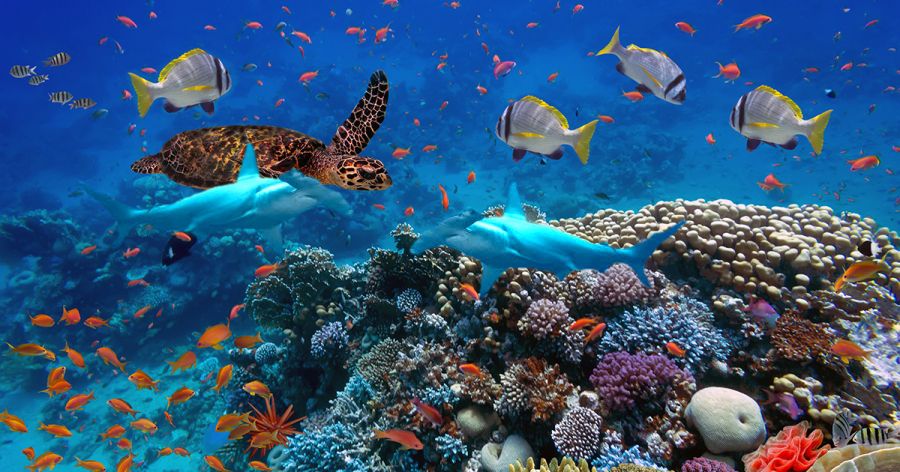
The oceans are one of the main reservoirs of biodiversity in the world, they are carbon sinks essential to climate regulation and therefore essential in our fight against climate change. They constitute more than 90% of the habitable space on the planet and are home to some 250,000 known species as well as many species still unknown.
A few months after the adoption of an agreement at COP15 on biodiversity aimed at protecting 30% of the land and 30% of the seas by 2030, the adoption of a treaty on the conservation and sustainable use of marine biodiversity in the high seas is a key step in protecting the ocean and its biodiversity and enabling a fair sharing of its resources.
A historic agreement after years of talks
This first international treaty for the protection of the high seas was adopted on March 4 by the member countries of the United Nations. An agreement described as historic, at a time when the health of the oceans is threatened by global warming, plastic pollution, overfishing and mining exploration of the seabed.
The new agreement came after more than 15 years of discussions, including 4 years of formal negotiations between UN member states. However, it must be ratified by the 190 member countries before it comes into force.
This treaty aims to develop a legally binding international instrument to strengthen governance of the high seas and establish the tools necessary for effective protection of the ocean and sustainable use of its resources.
The high sea is international waters, which begin at the limit of the exclusive economic zones of the States, ie 370 km from the coast. The high seas make up more than 60% of the oceans. Above all, it constitutes nearly half (45%) of the Earth's surface.
About 1% of international waters are currently subject to protective measures. With this new agreement, marine protected areas could be created on the high seas. The new global framework for biodiversity, adopted in Montreal last December, plans to protect 30% of the oceans.
Climate sponges
Since the beginning of the industrial revolution, around 1750, the oceans have absorbed around a quarter of the CO2 emissions released into the atmosphere. They have also absorbed almost all of the excess heat caused by rising greenhouse gases, 93% over the past 40 years. Without the oceans, the effects of global warming would be even greater. But by thus playing the role of climatic sponge, the oceans are acidifying and warming up, which profoundly modifies certain marine ecosystems.
According to the UN, approximately 90% of the populations of commercially exploited fish species are depleted or nearing depletion.
A mining eldorado at the bottom of the Pacific
If terrestrial reserves of nickel are estimated at 230 million metric tons, those located at the bottom of the oceans are estimated at 306 million metric tons. However, the demand for this ore is on the rise, in particular to ensure the production of electric cars. This is also the case for cobalt and rare earths, whose underwater reserves are very much greater than those found on land.
Called the Clarion-Clipperton zone, this approximately 7,200 km long geological fracture has an area of 4.5 million square meters, almost three times the area of Quebec. At a depth of 4000 to 5000 meters, there are significant amounts of cobalt, rare earths, nickel and manganese. Several mining exploration permits have been issued by the International Seabed Authority in recent years.
Almost unknown areas
Several scientists and environmental groups are calling for caution regarding seabed mining exploration. They cite in particular the lack of knowledge of these areas, which are more difficult to explore than terrestrial environments. In these circumstances, the impacts of mining activities, for example, could be underestimated due to a lack of information.
One of the most important elements of the new agreement is that it includes the obligation to carry out environmental impact studies for proposed activities on the high seas, in areas beyond national jurisdiction. |
|
|
|
| Britney Delsey for DayNewsWorld |
 |
THE UN HAS CONCLUDED AN AGREEMENT FOR THE PROTECTION OF THE HIGH SEAS
|
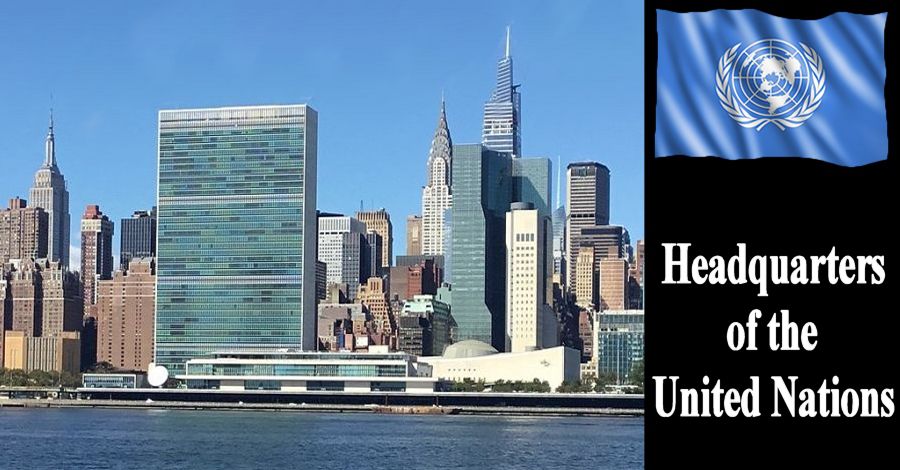
The member states of the UN finally agreed on Saturday on the first international treaty to protect the high seas, intended to counter the threats to ecosystems vital to humanity.
"The ship has reached shore," conference president Rena Lee said.
After more than 15 years of discussions, including four years of formal negotiations, the third "last" session in New York was finally the right one, or almost. Delegates finalized the text with content now frozen in substance, but it will be formally adopted at a later date after it has been vetted by legal services and translated to be available in the six official UN languages.
"A major step"
Despite everything, “this is a major step”, commented before the agreement Veronica Frank, of Greenpeace, stressing that care should however be taken that this process is not “a back door to reopen questions”.
With the progress of science, proof has been made of the importance of protecting these oceans, teeming with an often microscopic biodiversity, which also provides half of the oxygen we breathe and limits global warming by absorbing important part of the CO2 emitted by human activities.
But the oceans are weakening, victims of these emissions (warming, acidification of the water, etc.), pollution of all kinds and overfishing.
The high seas begin where the Exclusive Economic Zones (EEZ) of the States end, at a maximum of 200 nautical miles (370 km) from the coasts and are therefore not under the jurisdiction of any State.
The new treaty, when it comes into force, after being formally adopted, signed and then ratified by enough countries, will create marine protected areas in these international waters. |
|
|
|
| Boby Dean for DayNewsWorld |
 |
DEATH OF PALEONTOLOGIST YVES COPPENS | 
French paleontologist Yves Coppens has died at the age of 87. “Yves Coppens left us this morning. My sadness is immense, ”wrote its editor Odile Jacob on Twitter on Wednesday, hailing “a very great scholar”. “I am losing the friend who entrusted me with all his work. France loses one of its great men. »
Born on August 9, 1934 in Vannes, to a father who was a teacher at the Jules-Simon high school and a pianist mother, Yves Coppens had spent his childhood near Conleau, a small Breton peninsula attached to the Morbihan area in the 1930s. He had done part of his studies in Rennes.
As a young doctor, he joined the National Center for Scientific Research (CNRS) in 1956 and initially focused on mammoth teeth. His thesis is on prehistoric elephants. He is 22 years old. It was with the aim of elucidating the origin of the Carnac alignments that he said he enrolled in archeology at the Sorbonne. He had continued in this direction by specializing, in the third cycle, in paleontology.
Lucy's Discovery
Former director of the National Museum of Natural History, holder of the chair of paleontology and prehistory at the Collège de France, he owes his notoriety above all to his discovery of the Australopithecus fossil nicknamed Lucy, 3.2 million years old, discovery in 1974 in Ethiopia during an international mission that he co-led with the American Donald Johanson and the French geologist Maurice Taieb. It was the latter, who died in July 2021, who put the team on the trail of this fossil, soon to be considered the grandmother of humanity – or its great-aunt, depending on the interpretation. This skeleton of a prehistoric woman - discovered in 52 fragments - (recent studies question the sex of this individual) officially bore the scientific name of Autralopithecus afarensis, in reference to this region of Afar, in northeastern Ethiopia, where it was discovered. But the members of the Franco-American mission had renamed her Lucy in reference to a Beatles hit ("Lucy in the Sky with Diamonds") which was on the radio at the time of her exhumation.
Lucy has sometimes been considered the ancestor of modern humans, before research into the origins of mankind challenged this presentation.
“Lucy is three million two hundred thousand years old and the first man is three million years old, explained Yves Coppens himself. I apologize to Lucy but I don't think she's our grandmother! »
This skeleton was for a long time the most complete hominid fossil ever found for such an ancient period (the skeletons of Ardi, in the early 1990s, and Selam, in 2000, respectively more than 4 and 3.4 million years ago).
Ambassador of prehistory
For fifty years, he criss-crossed the Ethiopian desert thanks to an annual campaign of excavations on the banks of the dry Aouache river.
Yves Coppens' fame was worldwide. Thanks to conferences and seminars, the paleontologist had visited the five continents. . He never stopped traveling the world to make his work known.
An outstanding pedagogue and born populariser, Yves Coppens adopted the tone of the storyteller which earned him the recognition of the general public.
|
|
|
|
| Jenny Chase for DayNewsWorld |
 |
There are no translations available.
MARS FUT AUSSI UNE PLANETE BLEUE
|
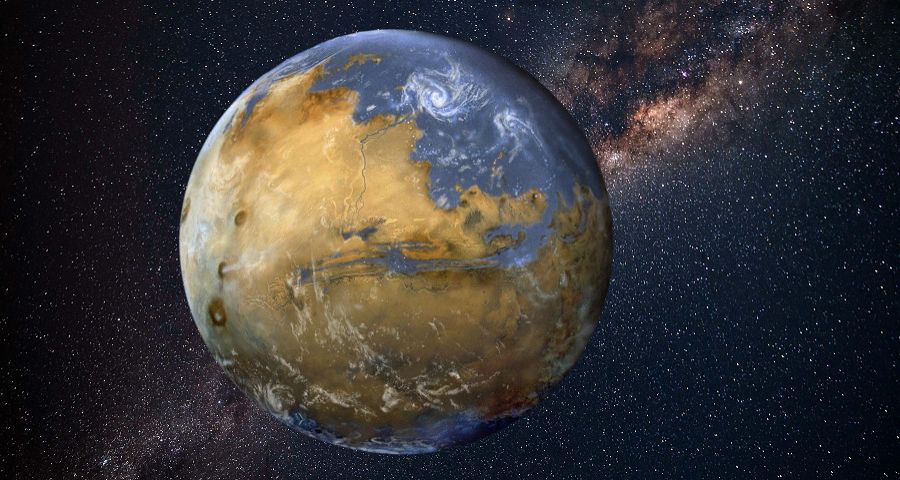 Un océan d'une surface dix fois plus grande que la Méditerranée couvrait la planète Rouge il y a 3 milliards d'années.a planète Rouge abritait jadis des lacs et rivières qui ont laissé leur empreinte dans la géologie… mais probablement aussi un immense océan ! Un océan d'une surface dix fois plus grande que la Méditerranée couvrait la planète Rouge il y a 3 milliards d'années.a planète Rouge abritait jadis des lacs et rivières qui ont laissé leur empreinte dans la géologie… mais probablement aussi un immense océan !
Situé dans les régions polaires de l'hémisphère Nord, il devait avoir une profondeur de 2 000 mètres en moyenne et couvrir une surface dix fois plus importante que la Méditerranée. Surtout, il devait être encore stable il y a 3 milliards d'années, soit 1,5 milliard d'années après la formation de Mars et des autres planètes du Système solaire.
Une étude franco-américaine publiée dans la revue PNAS conforte cette hypothèse en fournissant, pour la première fois, des arguments climatiques. Ils s'ajoutent aux indices géomorphologiques collectés depuis plus de trente ans par les robots martiens. « Il manquait toutefois une démonstration théorique : un modèle expliquant comment le climat martien aurait pu préserver un océan sur une aussi longue période », note Frédéric Schmidt, chercheur au laboratoire GEOPS de l'université Paris-Saclay.
C'est cette pièce manquante que son équipe apporte. Grâce à des simulations informatiques complexes, elle montre que les glaciers ont pu faire redescendre la neige des montagnes et alimenter l'océan ; et que la circulation océanique, qui conduit l'eau chaude vers les régions polaires, aurait permis de conserver une température légèrement supérieure à 4° C, au-dessus du point de congélation.
« Si ce scénario se confirme, Mars aurait pu être propice au développement de la vie il y a 3 milliards d'années.
Car, à la même période sur Terre, la vie explosait et commençait à conquérir de nombreux écosystèmes », rappelle Frédéric Schmidt.
Mars en revanche a peu à peu perdu son atmosphère, son climat et donc son océan.
|
|
|
|
| Simon Freeman pour DayNewsWorld |
 |
WITH THE "OVEREXPLOITATION OF THE EARTH"
THE "VITAL SIGNS" OF THE PLANET ARE WEAKENING |
In their text published in the journal Bioscience, a group of 14,000 scientists, who advocated the declaration of a global climate emergency, believe that governments have systematically failed to tackle the causes of climate change: “ overexploitation of the Earth ”.
Since an assessment in 2019, they have already highlighted the "unprecedented increase" in climatic disasters, from floods to heatwaves, through cyclones and fires.
Earth is absorbing more and more heat, causing energy imbalance and global warming, according to NASA and NOAA
18 out of 31 vital signs hit records
While climate disasters have been linked in recent months, scientists estimate that of the 31 "vital signs" of the planet (greenhouse gas emissions, melting ice, deforestation, etc.), 18 are reaching records.
For example, they warn that glaciers are melting 31% faster than fifteen years ago, that deforestation in the Amazon reached a record high in 2020, turning this crucial carbon sink into a net emitter of CO2. Or that greenhouse gas emissions have reached a level never seen in 2021.
And with a record over 4 billion head of cattle, including cows and sheep, the mass of cattle now exceeds that of humans and wild animals combined.
Quick and radical measures
"We need to respond to the evidence that shows we are heading towards climate breaking points, taking urgent action to decarbonize the economy and start restoring nature rather than destroying it," said one of the authors, Tim Lenton, UK University of Exeter. The authors believe that there is indeed "growing evidence that we are approaching, if not already passed" some of the tipping points that could lead the climate system to a dramatic and irremediable change. This included e t melting ice sheets in Greenland and Antarctica, which could be irreversible across several centuries even if CO2 emissions were reduced.
Another possible point of no return: the coral reefs threatened in particular by global warming, and on which half a billion people depend.
Stop overexploiting resources
The authors therefore believe that rapid and radical action is necessary in several areas: eliminating fossil fuels, reducing pollution, restoring ecosystems, opting for plant-based diets, moving away from the current growth model and stabilize the world population.
According to William Ripple of Oregon State University, "policies, to combat the climate crisis or any other symptom should tackle the source: overexploitation of the planet by humans."
|
|
|
|
| Alyson Braxton for DayNewsWorld |
 |
MALESE RATS GIVE BIRTH TO SMALLA CHINESE EXPERIENCE LIKE FRANKENSTEIN |
 Chinese scientists forced male rats to give birth to young through Frankenstein-style experiments. This "feat" is attributed to a team from Shanghai Naval Medicine University. She succeeded in reproducing a model of pregnancy in a male rat. Chinese scientists forced male rats to give birth to young through Frankenstein-style experiments. This "feat" is attributed to a team from Shanghai Naval Medicine University. She succeeded in reproducing a model of pregnancy in a male rat.
A turning point in research on male reproduction
The team from the Shanghai Naval Medicine University has in fact constructed a model of pregnancy in the male rat in four stages.
The first step was to match a male rat with a female at the skin level. The two specimens then shared their blood. In the next step, the researchers transplanted the uterus of another female into the male. Then the embryos were implanted in the male and the female.
The research team allowed the embryos to develop for 21 and a half days before performing a cesarean section. The fourth and final step was to separate the rats.
The male specimens were able to survive three months after the operation. The mice resulting from the experiment managed to reach adulthood without any health problems.
However, not all of the embryos survived. The prepublication mentions abnormally dead fetuses. Their morphology and colors distinguished them from normal fetuses. According to the report, the deaths were caused by swelling or atrophy of the placenta.
“For the first time, we have built a model of pregnancy in a male mammal. Our study reveals the possibility of normal embryonic development in male mammals, and this may have a profound impact on research in reproductive biology, ”conclude the researchers in the paper.
A Frankenstein experience
If Victor Frankenstein indulges in a foul practice to bring his creature to life in the famous novel Frankenstein or Modern Prometheus by Mary Shelley, it remains fiction. The mad scientist manages to bring an artificial creature to life by assembling different pieces of corpses.
The Chinese study, on the other hand, is very real. And she can only question.
The association For an Ethics in the Treatment of Animals (PETA) reacted immediately. His advisor Emily McIvor talks about a despicable study only "to establish if they could have cubs" after torturing the rats. "Surgically assembling two sensitive rats - which have endured mutilations and weeks of prolonged suffering - is unethical and is Frankenstein's science," McIvor told the Daily Mail . She told Mail Online: “In this despicable study, after being castrated and forcibly married to a female rat, male rats were cut and implanted with a uterus and embryos were inserted into it - all to establish s 'they could "successfully" produce young people.
"These shocking experiences are driven solely by curiosity and do nothing to deepen our understanding of the human reproductive system. "
"Animals deserve to be respected and left in peace, not raised in laboratories, experienced and treated as disposable items."
|
|
|
|
| Garett Skyport for DayNewsWorld |
 |
"IRREVERSIBLE" CONSEQUENCES
OF GLOBAL WARMING |
Life on Earth as we know it will inevitably be transformed by climate change when children born in 2021 will be 30 years old, or even earlier, warns a draft report by UN climate experts. "Humanity cannot"
Whatever the rate of reduction of greenhouse gas emissions, the devastating impacts of warming on nature and the humanity that depends on it will accelerate, assures the Intergovernmental Panel on Climate Change ( IPCC), and become painfully palpable well before 2050. “Life on Earth can recover from major climate change by evolving into new species and creating new ecosystems,” notes the 137-page technical summary. “Humanity cannot”.
Inform political decisions
The draft report drafted by hundreds of scientists attached to the IPCC, which is authoritative in the field, oscillates between an apocalyptic tone and the hope offered to men to change their destiny by immediate and drastic measures. The comprehensive 4,000-page evaluation report, much more alarmist than the previous one in 2014, aims to inform political decisions. Although its main findings will not change, it will not be officially released until February 2022, after its approval by consensus by all 195 member states. Too late, however, for the crucial international meetings on climate and biodiversity scheduled for the end of 2021, note some scientists.
Among its most important conclusions is a lowering of the threshold beyond which warming can be considered acceptable. By signing the agreement in Paris in 2015, the world has pledged to limit global warming to 2 ° C compared to pre-industrial times, if possible + 1.5 ° C . From now on, the IPCC estimates that exceeding + 1.5 ° C could already lead "gradually, to serious consequences, for centuries, and sometimes irreversible".
The lives of our children and grandchildren
And according to the World Meteorological Organization, the probability that this threshold of + 1.5 ° C over one year will be exceeded by 2025 is already 40%. "The worst is yet to come, with implications for the lives of our children and our grandchildren far more than ours", insists the IPCC, while awareness of the climate crisis has never been so extensive .
Even at + 1.5 ° C, living conditions will change beyond the ability of some organisms to adapt.
The climate has already changed. While the rise in average temperatures since the middle of the 19th century has reached 1.1 ° C, the effects are already severe and will be increasingly violent, even if CO2 emissions are curbed. And the living things - human or not - least to blame for these shows are, ironically, those who will suffer the most. For some animals and varieties of plants, it may even be too late: "Even at + 1.5 ° C, living conditions will change beyond the ability of certain organisms to adapt", emphasizes the report, citing the coral reefs on which half a billion people depend. Among the species on borrowed time are the animals of the Arctic, a territory that is warming three times faster than average. On site, ancestral ways of life,people living in close connection with the ice could also disappear.
Agriculture, breeding, fishing, aquaculture ....
"In all food production systems, sudden losses increase", also observes the report, pointing to climatic hazards as "the main driver". However, humanity is at this stage not armed to face the certain deterioration of the situation. "The current levels of adaptation will be insufficient to respond to future climate risks", warns the IPCC. Even limiting the increase to 2 ° C, up to 80 million more people will go hungry by 2050 and 130 million could fall into extreme poverty within ten years.
Cascading effects
In 2050, hundreds of millions of inhabitants of coastal cities will be threatened by more frequent wave-submersion, caused by rising sea levels, which in turn will lead to significant migrations. At + 1.5 ° C, in cities, 350 million additional inhabitants will be exposed to water shortages, 400 million at + 2 ° C. And with that extra half-degree, 420 million more people will be at risk from extreme heatwaves. “The costs of adaptation for Africa are expected to increase by tens of billions of dollars per year above + 2 ° C,” the report predicts. We still have to find this money.
The danger of cascading effects
The text also underlines the danger of cascading effects. Some regions (eastern Brazil, Southeast Asia, central China) and almost all coastal areas could be hit by three or four simultaneous weather disasters, or even more: heatwave, drought, cyclone, fires, floods, diseases carried by people. mosquitoes ... And we must also take into account the amplifying effects of other human activities harmful to the planet, notes the report: destruction of habitats, overexploitation of resources, pollution, spread of diseases ...
The "tipping points"
Without forgetting the uncertainties around the “tipping points”, key elements whose substantial modification could lead the climate system towards a violent and irremediable change. Above + 2 ° C, the melting of the Greenland and West Antarctic ice caps (which contain enough water to cause the sea level to rise by 13 meters) could for example cause a point of no return, according to recent work. This is why "every fraction of a degree counts", insists the IPCC, while another breaking point could see the Amazon - one of the lungs of the planet with the oceans - transformed into a savannah.
A note of hope
Faced with these systemic problems, there is no single miracle cure. In contrast, a single action can have positive cascading effects. For example, the conservation and restoration of mangroves and submarine kelp forests, referred to as “blue carbon” sinks, increase carbon storage, but also protect against flooding, while providing habitat for many species. and food for coastal populations.
Despite its alarming conclusions, the report thus offers a note of hope. Humanity can still orient its destiny towards a better future by taking strong measures today to slow down the runaway of the second half of the century. “We need a radical transformation of processes and behaviors at all levels: individuals, communities, companies, institutions and government,” argues the report. “We need to redefine our way of life and consumption.”
For her part, the young activist in the fight against climate change, Greta Thunberg, welcomed Wednesday, June 23, 2021 the draft UN report on the climate which allows the world to see "reality in the face".
"The world faces complex interwoven challenges," comments Nicholas Stern, a climate economist, not involved in this report. "Unless we face them at the same time, we will not meet any," he said.
|
|
|
| | Andrew Preston for DayNewsWorld |
 |
NYIRAGONGO ERUPTION
AFRICA'S MOST DANGEROUS VOLCANO |
 Located near Goma, in the east of the Democratic Republic of the Congo (DRC), the Nyiragongo, which erupted on Saturday May 22, is the most active volcano in Africa and is considered by specialists as one of the most dangerous. Located near Goma, in the east of the Democratic Republic of the Congo (DRC), the Nyiragongo, which erupted on Saturday May 22, is the most active volcano in Africa and is considered by specialists as one of the most dangerous.
This strato-volcano which has fascinated entire generations of volcanologists is, with Nyamuragira, one of the two volcanoes still active in the Virunga range, in this central African country. It is located in the densely populated region of Goma and poses a threat to around 1.5 million people.
Culminating at 3,470 meters, it is known to be home to the largest almost permanent lava lake in the world, the level of which rises and falls from time to time. Its dangerousness is due to the fact that its lava flows are extremely fast, being able to descend a slope at 100 km / h.
Deadly lava flows
A previous eruption, in January 1977, had been even more deadly. The lava had also reached Goma and caused the death of several hundred people (the balance sheets vary from 600 to 2,000) in the northern outskirts of the city. It is the deadliest lava flow known, as well as the largest flow (about 20 million cubic meters in half an hour).
In 1982, a new lava lake reappeared. And in 1994, when the genocide in Rwanda brought refugees into the area, a new activity in Nyiragongo had caused great concern, as nearly 800,000 people were camping between Goma and the volcano. An eruption comparable to that of 1977 would then have provoked an unprecedented catastrophe.
After the 2002 eruption, a seismic observatory was created in Goma, the Volcanological Observatory of Goma (OVG), in order to monitor both Nyiragongo and Nyamuragira.
|
|
|
|
| Paul Emison for DayNewsWorld |
 |
THE BIGGEST ICEBERG IN THE WORLD
DETACHED FROM THE ANTARCTIC BANQUISE |
Until then, the record for the largest iceberg in the world was held by A-23A, an iceberg of more than 3,300 km². This new block of ice, dubbed A-76, has an area of 4,320 km². The largest iceberg in the world, half the size of Corsica, broke off on Wednesday 19 May from the Ronne sea ice in Antarctica, according to images from a satellite of the European program Copernicus. The huge chunk of ice has since been adrift in the Weddell Sea. 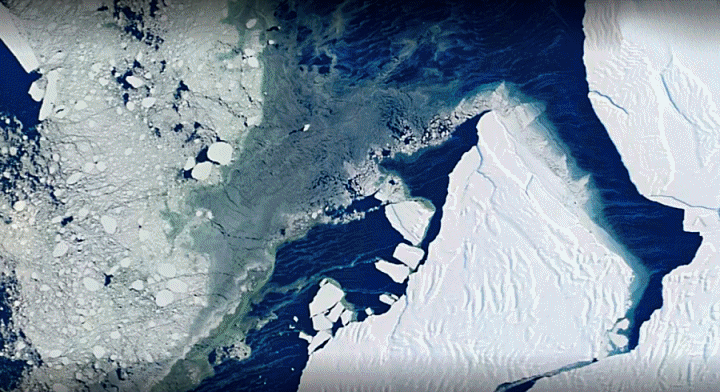
The iceberg, called A-76, is approximately 170 km long and 25 km wide, for a total area of 4,320 km².
It was originally spotted by the British Antarctic Survey (BAS), a British polar research organization, which has a base nearby.
According to the English-language journal LiveScience, this event should not have an impact on sea level, because the pack ice from which A-76 detached was already floating. The U.S. Center for Information in Support of Polar Research (NSIDC) also explained that the continent of Antarctica, which is warming at a faster rate than the rest of the planet, contains enough ice to raise the overall sea level of 60 meters.
Its scientists believe that climate change, caused by human activity, had not triggered the detachment of the iceberg, nor that of its predecessor, A-74, which broke away in February. "A-76 and A-74 are part of the natural cycle of the ice floes, from which no large piece has detached in decades, ”said Laura Gerrish, researcher at BAS on Twitter. "It is important to monitor the frequency of iceberg formation, but these [A-76 and A-74] were expected," she also said.
Until A-76, the record for the largest iceberg in the world was held by the A-23A, a 3,880 km² iceberg drifting in the Weddell Sea, according to the European Space Agency. |
|
|
|
| Paul Emison for DayNewsWorld |
 |
WHICH HUMAN CRIES FOR WHICH EMOTIONS ?
|

The 're shouting is a primal form of communication, pre-linguistic, that is found with relatives of the human lineage as primates, and in most mammals. And they mainly convey, in the animal world, notions of urgency and alarm: the goal is to attract the attention of others in order to signal a predator, an immediate danger ... However, the cries are much more varied than previously thought, assures us the study of a team from the University of Zurich published Tuesday, April 13 in the journal "PLOS Biology".
"Humans cry out not only when they are frightened or aggressive, but also when they sense other emotional states, and these various states that cause screaming are similar to a variety of inner emotional states that are most often expressed. by less intense non-verbal vocal emotions, such as sadness, joy and sensual pleasure ”, detail these scientists.
Human screams communicate at least ... six emotions
We use the cry to express six different emotions. Unlike primates, which use screaming to communicate only anger and fear, humans scream to express six different emotions: anger, fear, pain, sadness, pleasure, and joy. And contrary to what one might think, we detect and decipher these more quickly than alarming cries, according to the study published in the scientific journal.
“The results of our study are surprising,” says Sascha Frühholz, lead author.
Certainly, it is impossible to remain unmoved or forget the mythical cries of Shelley Duvall in Shining or that of Janet Leigh in Psychosis. However, in humans, "screaming communication appears to have diversified widely," which represents "a major evolutionary step" according to the University of Oslo psychology professor.
More likely to hear positive cries
"Humans share with other species the ability to signal danger by shouting, but it seems only humans shout to signal positive emotions as well," the scientist continues.
For this study, the researchers used four psychoacoustic, perceptual, and neuroimaging decision-making experiments in tests with 12 participants. The results revealed six psycho-acoustically distinct types of screaming, which indicated pain, anger, fear, pleasure, sadness, and joy. Listeners responded faster, more accurately, and with higher neural sensitivity, to non-alarming, positive cries than to alarming cries. Specifically, less alarming screams elicited more activity in many auditory and frontal brain regions. According to the authors, these results show that cries are more diverse in their nature of signaling and communication in humans.
"A major evolutionary step"
“Crying communication seems to have become widely diversified in humans, which represents a major evolutionary step,” summarizes Dr. Frühholz.
Before concluding: “Humans share with other species the potential to signal danger by shouting, but it seems only humans shout to also signal positive emotions such as extreme joy and pleasure. "
How to explain it? For the author of the study, this result may be linked to the fact that humans have to deal with more complex situations and social signals than chimpanzees and other primates. They are also more likely to hear expressions of pleasure, joy and surprise than expressions of fear in their family life and social circles. They therefore react more quickly to these signals.
"This change in priority could be due to the requirements of evolved and complex social contexts in humans" , concludes the specialist.
|
|
|
|
| Emily Jackson for DayNewsWorld |
 |
| 
|
|  |
There are no translations available.
LES GEMENIDES UNE PLUIE D'ETOILES FILANTES
|
 Le ciel va
se donner en spectacle en ce jour de décembre. Une pluie de météores,
connue sous le nom de Géminides, devrait connaître son apogée dans la
nuit de dimanche 13 à lundi 14 décembre 2020, alors que la Terre passe, comme
chaque année à cette même période, à travers la traînée de poussières
laissée par l'astéroïde Phaéton, un objet céleste mal défini, entre
l'astéroïde et la comète, détaille Futura-Sciences. Le ciel va
se donner en spectacle en ce jour de décembre. Une pluie de météores,
connue sous le nom de Géminides, devrait connaître son apogée dans la
nuit de dimanche 13 à lundi 14 décembre 2020, alors que la Terre passe, comme
chaque année à cette même période, à travers la traînée de poussières
laissée par l'astéroïde Phaéton, un objet céleste mal défini, entre
l'astéroïde et la comète, détaille Futura-Sciences.
C'est la plus belle
pluie d’étoiles filantes de l’année :
les Géminides
Nouvelle lune, conditions optimales
Cette
année, les conditions d’observation seront particulièrement favorables
puisque la nouvelle lune, trop basse, n’éclairera pas le ciel.
Afin d’en
profiter au mieux, il est conseillé de choisir un site naturel préservé
de la pollution lumineuse des grandes villes.
Le pic d’intensité est prévu entre minuit et 4 heures du matin.
|
|
|
|
| Boby Dean pour DayNewsWorld |
 |
There are no translations available.
LES PLUS RICHES EMETTENT BEAUCOUP PLUS
DE GAZ A EFFET DE SERRE QUE LES PLUS PAUVRES
|
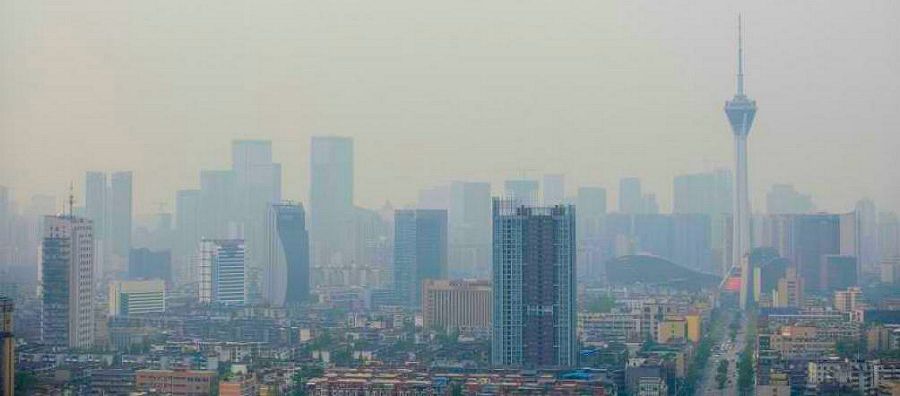 Les 1% les plus riches du monde émettent deux fois plus de gaz à effet de serre que la moitié la plus pauvre de la population, selon un rapport d’Oxfam. Les 1% les plus riches du monde émettent deux fois plus de gaz à effet de serre que la moitié la plus pauvre de la population, selon un rapport d’Oxfam.
Pour ce résultat, l’ONG s’est penchée sur la période 1990-2015. Vingt cinq années pendant lesquelles les émissions mondiales de CO2, responsables du réchauffement de la planète qui a déjà gagné plus de +1°C depuis l’ère préindustrielle, ont augmenté de près de 60%.
Selon son analyse, « les 1% les plus riches de la population (environ 63 millions de personnes) étaient responsables à eux seuls de 15 % des émissions cumulées », soit « deux fois plus que la moitié la plus pauvre de la population mondiale ».
Et les 10% les plus riches de la population mondiale (environ 630 millions de personnes) étaient responsables de 52% des émissions de CO2 cumulées.La moitié la plus pauvre de l'humanité, plus de 3 milliards de personnes, ne pèse en revanche que 7 % des émissions.
Les plus pauvres sont les victimes
« Au cours des 20-30 dernières années, la crise climatique s’est amplifiée et le budget carbone mondial limité a été dilapidé au service d’une intensification de la consommation d’une population nantie, et non pour sortir des personnes de la pauvreté », dénonce Oxfam.
Et les groupes qui « souffrent le plus de cette injustice sont les moins responsables de la crise climatique »: les plus pauvres et les générations futures, poursuit l’ONG, appelant les gouvernements du monde entier à rectifier le tir en plaçant justice sociale et lutte contre le climat au cœur des plans de relance économique post-Covid.
« Il est clair que le modèle de croissance économique très émetteur de carbone et très inégalitaire des 20-30 dernières années n’a pas bénéficié à la moitié la plus pauvre de l’humanité », a dénoncé Tim Gore, expert de l’ONG.
« C’est une dichotomie fallacieuse de suggérer que nous devons choisir entre la croissance économique et le climat », a-t-il ajouté.
L'ONG, qui dénonce une surconsommation dévastatrice, appelle à saisir l'opportunité des plans de relance post-Covid pour rétablir une justice climatique. Au rythme actuel, le budget carbone pour limiter le réchauffement de la planète à 1,5 °C sera épuisé dans dix ans.
« La pandémie de COVID-19 fait inévitablement ressortir la nécessité de reconstruire mieux et d’inscrire l’économie mondiale sur une voie plus juste, plus durable et plus résiliente », a réagi dans le rapport l’ancien secrétaire général de l’ONU Ban Ki-moon.
« Cet engagement collectif doit avoir comme priorité de réduire les émissions de CO2 de la frange la plus riche de la société, qui pollue de manière disproportionnée »
|
|
|
|
| Boby Dean pour DayNewsWorld |
 |
There are no translations available.
750 MILLIONS DE MOUSTIQUES
GENETIQUEMENT MODIFIES EN LIBERTE
|
Les autorités de Floride lâchent 750 millions de moustiques génétiquement modifiés 750 millions de moustiques génétiquement modifiés vont être lâchés sur deux ans dans un archipel de Floride. Ils devront réduire la population de moustiques Aedes Aegypti, porteurs de maladies comme le Zika ou la dengue.
Plutôt que des insecticides, les autorités locales des Keys, un archipel au sud de la Floride, ont approuvé ce mardi la libération sur deux ans de 750 millions de moustiques génétiquement modifiés. Ces derniers ont pour mission de lutter contre le moustique Aedes Aegypti, porteur de maladies comme le Zika, la dengue, le chikungunya ou la fièvre jaune, rapporte la BBC.
Des moustiques pour lutter contre d’autres moustiquesCes moustiques OGM, uniquement des mâles, sont développés par l’entreprise de biotech américaine basée au Royaume-Uni, Oxitec. Ils ne se nourrissent pas de sang et possèdent un gène empêchant la progéniture femelle de survivre au-delà de l’enfance. Ils se reproduiront avec des moustiques femelles sauvages qui, elles nécessitent du sang humain pour produire des œufs. Progressivement, la population de moustiques devrait décroître et ainsi réduire le nombre de contaminations.
|
|
|
|
| Carl Delsey pour DayNewsWorld |
 |
COLLAPSE OF THE LAST CANADIAN ARCTIC GLACIER PLATFORM
|
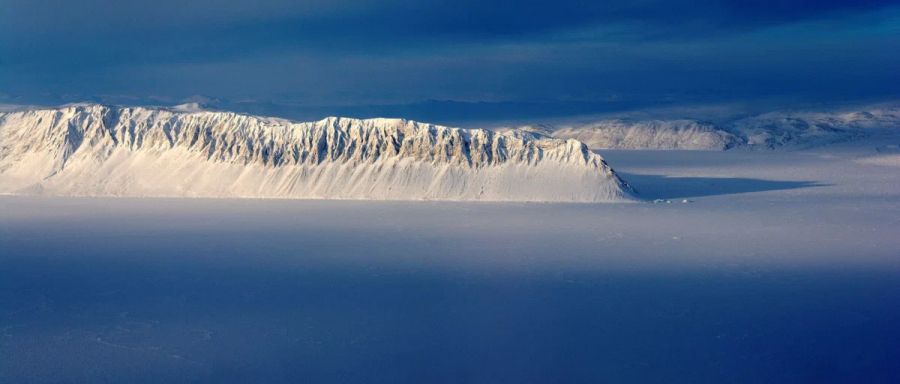
The last intact ice shelf in the Canadian Arctic has just collapsed, according to information posted on social networks, Thursday, August 6, 2020, by the Canadian Ice Service (ECCC).
This platform belonged to the Milne Ice Shelf, located on Ellesmere Island in the sparsely populated territory of Nunavut, which has now lost 43% of its area, or 80 km2.
By comparison, Manhattan Island, New York, covers approximately 60 km2. "It was the largest ice shelf still intact"
The rupture was caused by "higher than normal air temperatures, offshore winds and open water in front of the ice shelf," the ECCC said on Twitter.
“It was the largest ice shelf still intact, and it disintegrated,” said Luke Copland, a glaciologist at the University of Ottawa.
Ice shelves, or ice barriers, are pack ice (frozen seawater) on which glaciers are established, formed of compacted snow. By breaking up, these ice floes give rise to flat icebergs.
In the Arctic, the area covered by ice has declined by about 13% per decade over the past 40 years. |
|
|
|
| Simon Freeman for DayNewsWorld |
 |
There are no translations available.
COVID-19 MUTATION DU VIRUS « CHINOIS » EN UN VIRUS « EUROPEEN » PLUS INFECTIEUX
|
 Alors que le Covid-2019 dépasse les 10 millions de contaminations dans le monde, des chercheurs américains suggèrent dans une étude que le virus est devenu plus infectieux. La revue américaine Cell a publié ce jeudi une étude montrant qu'une variation du génome viral de COVID-19 a amélioré sa capacité à infecter les cellules humaines. Et l'a aidé à devenir la souche dominante circulant dans le monde aujourd'hui.. Alors que le Covid-2019 dépasse les 10 millions de contaminations dans le monde, des chercheurs américains suggèrent dans une étude que le virus est devenu plus infectieux. La revue américaine Cell a publié ce jeudi une étude montrant qu'une variation du génome viral de COVID-19 a amélioré sa capacité à infecter les cellules humaines. Et l'a aidé à devenir la souche dominante circulant dans le monde aujourd'hui..
Une « lettre » d'ADN qui fait la différence
Après sa sortie depuis la Chine et son arrivée en Europe, une variante du nouveau coronavirus, qui mute en permanence comme tout virus, est devenue dominante, et c'est cette version européenne qui s'est ensuite installée aux Etats-Unis. La variante, nommée D614G, concerne une seule lettre de l’ADN du virus.« D614G » modifie « légèrement mais efficacement » la glycoprotéine, la « pique » qui dépasse de la surface du virus, utilisée pour pénétrer dans les cellules humaines et les infecter. Cette variante du virus, semble infecter plus facilement les cellules que celle qui est apparue à l'origine en Chine, estiment les auteurs de cette étude, réalisés en analysant des échantillons du génome publiés sur la plateforme internationale GISAID.
Un virus qui infecte plus facilement les cellules
Les expériences en laboratoire ont montré que la variante était trois à six fois plus capable d'infecter des cellules humaines. Mais tout est dans le « probable » : une expérience in vitro (en laboratoire) ne peut reproduire la dynamique réelle d'une pandémie. Par
conséquent, la conclusion la plus stricte est que si le coronavirus
circulant actuellement est probablement plus « infectieux », il n'est
pas nécessairement plus « transmissible » entre humains.
Plus infectieux ne veut pas forcément dire plus dangereux
« Nous ne savons pas encore si une personne s’en sort moins bien avec elle ou non », a commenté Anthony Fauci, directeur de l’Institut des maladies infectieuses américain, à la revue Jama. Il semble que le virus se réplique mieux et puisse être plus transmissible, mais nous en sommes toujours au stade d’essayer de le confirmer. Mais il y a de très bons généticiens des virus qui travaillent là-dessus. »
|
|
|
|
| Simon Freeman pour DayNewsWorld |
 |
There are no translations available.
38°C EN SIBERIE
UN RECORD DE CHALEUR INQUIETANT
|
 La station de Verkhoyansk, au nord de la Sibérie orientale, a enregistré une température de 38 °C samedi 20 juin 2020, soit la valeur la plus élevée jamais observée au-delà du cercle polaire. Si le chiffre est confirmé, il battrait ainsi le précédent record de 37,3 °C du 25 juillet 1988 à cette même station. Du jamais vu en juin dans cette station météo connue pour être la plus froide de l’hémisphère nord où il n'est pas rare que le thermomètre y descende à -45 °C en hiver et la température annuelle moyenne culmine à -14,5 °C. La station de Verkhoyansk, au nord de la Sibérie orientale, a enregistré une température de 38 °C samedi 20 juin 2020, soit la valeur la plus élevée jamais observée au-delà du cercle polaire. Si le chiffre est confirmé, il battrait ainsi le précédent record de 37,3 °C du 25 juillet 1988 à cette même station. Du jamais vu en juin dans cette station météo connue pour être la plus froide de l’hémisphère nord où il n'est pas rare que le thermomètre y descende à -45 °C en hiver et la température annuelle moyenne culmine à -14,5 °C.
Des records de chaleur sur la durée
Plus que le record en lui-même, c'est la durée de la vague de chaleur qui est totalement inhabituelle. Après un hiver déjà largement au-dessus de la normale, la Sibérie a déjà enregistré son mois de mai le plus chaud avec des températures dépassant la normale de plus de 10 °C à certains endroits. Le 23 mai, la ville de Khatanga, encore plus au nord du cercle polaire, a enregistré une température de 25,4 °C, contre une température normale à cette date de... 0 °C.« L’hiver 2019-2020 a été le plus chaud en Sibérie depuis le début des relevés, il y a 130 ans, avec des températures moyennes jusqu’à 6°C au-dessus des normales saisonnières », rappelait début juin Marina Makarova, météorologue en chef de Guidrometsentr, l’agence météo russe. « Le printemps est aussi arrivé nettement plus tôt, en avril, avec des températures dépassant facilement (parfois) les 30°C », poursuivait-elle.
« Un dôme d’air chaud » bloqué sur la région
Comment l’expliquer ? D’abord par un phénomène météorologique. Depuis plusieurs jours et très certainement pour ceux à venir encore, une zone de hautes pressions s’est installée sur cette partie de la Sibérie pour ne plus en bouger, « dôme d’air chaud » constitué « d’anticyclones très puissants, avec beaucoup d’airs chauds en altitude et dans les basses couches ».Des anticyclones bloquants de ce type, il y en a toujours eu par le passé , mais ce qui change aujourd’hui c'est la masse d’air qu’ils charrient, qui est plus chaude qu’auparavant.
La crainte des « feux zombies »
Dans ce contexte, la crainte des feux de forêt ressurgit, la chaleur ayant certainement ravivé des feux « zombies », ces feux de toundra restés dormant dans le sol depuis les catastrophiques incendies ayant embrasé la région l'an passé, et qui pourraient se réactiver. Quelque 275.000 hectares auraient déjà brûlé en Yakoutie, selon l'agence gouvernementale de suivi des incendies. Une hypothèse qu’il reste encore à vérifier sur le terrain. Si elle se confirmait, la crainte serait alors d’avoir un nouvel été dramatique dans la région.
La probabilité de récurrence de ce genre d’événements extrêmes augmente avec le réchauffement climatique, deux fois plus important que la moyenne globale, auquel l’Arctique est particulièrement exposé .
|
|
|
|
| Alyson Braxton pour DayNewsWorld |
 |
WINTER FLAKES, SNOWMAN...
|
| However, for cold weather enthusiasts, the average annual temperature has risen by about 2 ° C since 1864, and most of this increase has occurred in recent decades.
Especially since the 1980s, snow has become rarer. According to current climate scenarios, this trend should continue.
What is the coldest city in the world ?
Welcome to Yakutsk, in central Siberia… a small town known for its cosmophysical research institute and for being the coldest place in the world. In January, temperatures often drop below - 40 ° C ... and it's a small neighboring town, Verkhoyansk, which holds the absolute record for the most freezing inhabited place, with a nice - 69.8 ° C.
On the other hand, level snowfall, it is on the side of Japan that we must turn, towards Aomori precisely. Its inhabitants can enjoy an average of 8 meters of snow per winter. 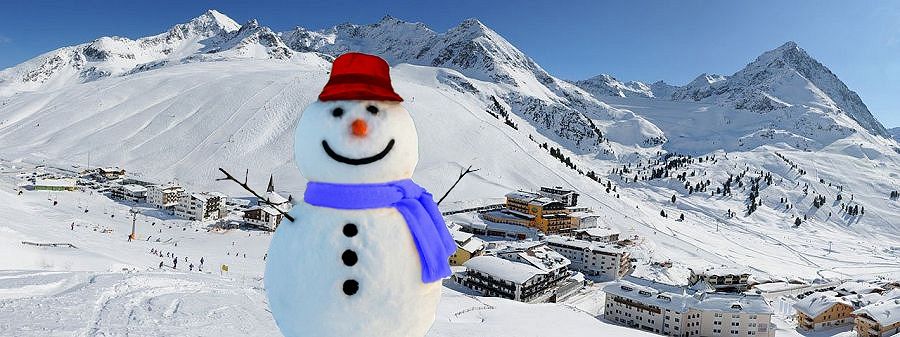
Are all the flakes the same size ?
No! We know it (or not), but each snowflake, a bit like a fingerprint, is unique. Their size too. According to "The Guinness Book of Records", a snowflake 38 cm wide and 20 cm thick fell at Fort Keogh, Montana, USA on January 28, 1887.
Is it less cold when it snows ?
Not really. Everything is about feeling. Who has not heard say: "It is normal that it is less cold, it snows.". Yet nothing is so simple in the wonderful world of weather.
“In fact, the colder the air mass, the less moisture it can contain, and the warmer it is, the more it can contain; This implies in winter that an air mass at - 2 ° C can contain more humidity than an air mass at - 10 ° C. So, theoretically yes, an air mass at - 2 could produce more snow than at - 10. There are always exceptions, but in general, this is the case. So in summary, we cannot say that it is less cold when it snows, but rather that on average it snows less when it is very cold. ”
What is the magic formula for making the best snowmen ?
Yes, a mathematical formula describes the ideal snow for shaping snowmen: it must be slightly humid (contain one fifth of water) and the outside air must be equal to or less than 0 ° C.
James Hind, a British mathematician, even created an ad hoc algebraic formula, respecting the famous golden figure in terms of proportions.
Basically, your creature should measure precisely 1.60 m and be composed of 3 balls of different sizes. The first measuring 80 cm, the second 50 and the third 30 cm.
Furthermore, his nose should consist of a carrot protruding 4 cm.
But in a context of global warming, you will have to climb higher and higher to make your snowman !
|
|
|
|
| Boby Dean for DayNewsWorld |
 |
IMPOSING RISK OF VOLCANO TAAL ERUPTION
IN THE PHILLIPPINES
|
|

"A dangerous eruption is possible in the hours or days to come," warned the national seismological agency.
A huge ash cloud rose Sunday over the Philippine Taal volcano, near Manila, causing thousands of evacuations and the cancellation of flights at the capital's airport for fear of an imminent eruption.
Government service seismologists have detected magma rising towards the crater while tremors were felt near the volcano, the top of which was lit by lightning.
Following this so-called "phreatic" eruption, a significant explosive eruption could occur "within a few days or weeks" if this activity continues, said Renato Solidum, head of the Institute of Volcanology and Seismology in the Philippines. Flights to and from Manila Ninoy Aquino Airport were canceled after the ash cloud reached 1.5 km. The region went on alert 4 for "risk of imminent dangerous eruption".
The Ring of Fire
More than 2,000 residents living on the island where the Taal is located, in the middle of a lake, have been evacuated as a safety measure, local authorities said. Residents of a neighboring island could also be evacuated if the situation worsens. “The ashes have already reached Manila. It's dangerous if people 'inhale,' said Renato Solidum.
The last eruption of Taal dates from 1977.
The Philippine archipelago is located on the Pacific “belt of fire”, where the tectonic plates collide, causing earthquakes and regular volcanic activity.
|
|
|
|
|
|
|
|
| Boby Dean for DayNewsWorld |
 |
THE MIKE HORN AND BORGE OUSLAND RESCUE EXPLORERS
|
| End of a perilous adventure where they almost died, starved and exhausted while on an Arctic expedition. Mike Horn and Borge Ousland were recovered by the Lance boat unharmed!
The happy news was announced on Mike Horn's Instagram account on Sunday, December 8, 2019, with photo supporting it. “Expedition 44 update. 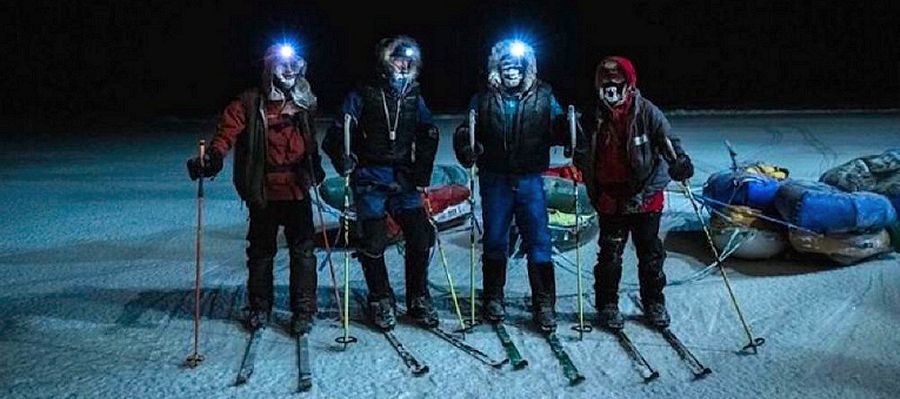 Approximately around midnight last night, Pangea received a call from Lance to announce that Mike Horn, @borgeousland, @aleksandergamme and @polarbengt have finally joined the ship unharmed. We will post more details when we have them, but for now it is time for our two heroes to let them enjoy a well-deserved rest after this incredible feat they have achieved, "it was published. . Approximately around midnight last night, Pangea received a call from Lance to announce that Mike Horn, @borgeousland, @aleksandergamme and @polarbengt have finally joined the ship unharmed. We will post more details when we have them, but for now it is time for our two heroes to let them enjoy a well-deserved rest after this incredible feat they have achieved, "it was published. .
South African explorer Mike Horn, presenter of "The Island" and his sidekick the Norwegian Borge Ousland, aged 53 and 57 respectively, found themselves in great difficulty, since November 22, in their ski crossing from the frozen Arctic Ocean.
The two adventurers had embarked on a crossing of the Arctic Ocean on skis. While initially they planned to complete the expedition in mid-November, the weather conditions forced them to progress more carefully than expected, the ice being thinner than usual and more inclined to drift. The explorers had to travel up to five kilometers more per day.
“The ice is breaking and moving much faster than before, which is one of the biggest challenges we have faced so far.
It's sad to admit to me, but in all my years as a professional explorer, I have never been so affected by climate change, "wrote Mike Horn, who fell into the water several times. times, to his daughters, Jessica and Annika.
Time was running out, their food ration reserves were running out and their physical state was deteriorating due to the darkness but also the very unstable temperatures, varying in a few days from - 2 ° C to - 45 ° C. What weaken the two adventurers and endanger their lives.
But today, the two famous adventurers are saved !
|
|
|
|
|
|
|
|
| Joanne Courbet for DayNewsWorld |
 |
THE STROMBOLI VOLCANO IN ERUPTION
|
|
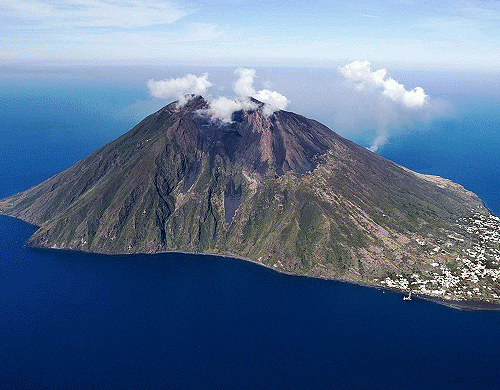
"Like a rain of fire falling from the sky". Stromboli, a volcano on the Aeolian Archipelago in Italy, erupted on Wednesday.
A particularly impressive phenomenon that caused the death of a tourist and caused the beginning of fires.
According to the Italian National Institute of Geophysics, two huge explosions occurred Wednesday on the south-central slope of the crater of the volcano around 4:45 pm French time.
The explosions were preceded by lava flows "from all active mouths", projecting a plume of smoke two kilometers high, said the INVG.
But the eruption this Wednesday, July 3 Stromboli differs from other volcanic explosions by its power. Stromboli, a very active volcano, has so far not experienced such strong eruptions, the last dating from 2003 and 2007.
In normal times, volcanic bombs are projected at 100 meters height, sometimes 200 meters. There he was 2 kilometers tall. The volcano has become "more explosive" because there is more gas that has accumulated in the reservoir.
As Stromboli is still active nothing allows scientists to predict its eruptions.
Despite the dangers, this area remains largely inhabited. The volcanic island of Stromboli, with an area of 12.6 km2, has about 500 inhabitants. It attracts many tourists every year from the beginning of spring.
This "very violent explosion" forced about a hundred tourists to snuggle into their homes, while others decided to find refuge at sea. Riflemen, the State Forestry Corps and fire brigades were dispatched to their homes. square.
Sicily, which was struck by a magnitude 4.8 earthquake on the Richter scale in 2018, experienced a new eruption of Etna in early June, with lava flows and ash columns. rising in the sky.
|
|
|
|
|
|
|
|
| Jaimie Potts for DayNewsWorld |
 |
A WORLD SCIENTIFIC FACTOR
AN ODYSSEE 28 DAYS UNDER THE SEA
|
|

The photographer and biologist Laurent Ballesta embarks on a new underwater adventure on Monday:
28 days at 120 meters deep, between Marseille and Monaco. Fascinated by Commander Jacques-Yves Cousteau, he takes the torch of his underwater exploits to explore the Mediterranean.
At 45, including thirty years of diving, he will live an extraordinary expedition. With his three teammates, they will live 28 days at sea, 120 meters deep, between Marseille and Monaco, behind closed doors.
"Exoticism is not at the end of the world. In the Mediterranean, there are virgin places, "says this passionate seabed.
 A challenge of nature: 28 days behind closed doors at 120 meters depth A challenge of nature: 28 days behind closed doors at 120 meters depth
For such a mission, it was necessary to defy nature. The pressure in this area - thirteen times that of the surface! - indeed requires long decompression times and significantly shortens the time of exploration.
"The problem of diving," he says, "is not the descent, it's the ascent. For a handful of minutes at great depth, it is hours and hours of ascent and decompression required.
"When you only spend thirty minutes at a depth of 120 meters, the climb lasts five hours! "Laments Laurent Ballesta.
To challenge nature and save time, Ballesta and his team came up with new techniques using practices already in place, but never before combined. The result is called "Gombessa V: Mediterranean Planet".
A twenty-eight day non-stop immersion in the aquatic "basements" of the Mediterranean
The solution is not to go back! So to work at 120 meters under water for 28 days, Laurent Ballesta and his divers will lock themselves in a pressurized box with steel walls.
More exactly in two modules of life including a dormitory module of 5m ² and a wet module with a bathroom and toilet, 2m ². With Ballesta, his long-time accomplices: Antin Guilbert, marine biologist, Thibault Rauby, instructor dive instructor and lighting assistant, and Yanick Gentil, cameraman.
Every day, a bell will sink divers up to 120 meters deep. They will rise to the surface to eat and rest, but still locked up and subjected to a pressure thirteen times that of the atmosphere.
The technique is not new in itself. A technique already used for divers in the offshore oil industry repairing pipelines.
But in this new adventure each diver will be equipped with submarine thrusters and fins. They will be able to travel the funds up to eight hours a day!
"The global feat is our freedom! declares the biologist (...) we will be able to move as we see fit in sites untouched by any observation. It's a turning point in the history of diving. If joining such depths is always a challenge, staying there was a fantasy. This summer, utopia will become reality. "
The objectives of this mission
Thanks to this odyssey, the themes of pollution, biodiversity and history will be invited ..., a dozen French and foreign laboratories having commissioned unpublished research protocols. Black coral forests and coral reefs or mapping areas, study of wastewater disposal sites, exploration of a wreck dating from the First World War will be studied.
On the ground a whole team of about thirty scientists.
Three cameras will monitor the divers day and night and their state of health. Because such living conditions alter the character. At the helm of the "saturation technique" team of the project, Théo Mavrostomos, a legend who holds the record of the "world's deepest man" with an experimental dive at 701 meters.
"" Mediterranean Planet "is a technical challenge in the service of knowledge, a human and sporting challenge to better know the Mediterranean," explains the chief explorer.
|
|
|
|
|
|
|
|
| Andrew Preston for DayNewsWorld |
 |
DISCOVERING A NEW HUMAN SPECIES
|
| A new human species has been discovered in the northern Philippines:
it has been named Homo luzonensis by scientists.
 Through the analysis of thirteen remains of fossils (teeth, phalanges of foot and hand, fragments of femur) found in the cave of Callao, researchers considered that it was a new species, they have named Homo luzonensis. Through the analysis of thirteen remains of fossils (teeth, phalanges of foot and hand, fragments of femur) found in the cave of Callao, researchers considered that it was a new species, they have named Homo luzonensis.
It presents at the same time "elements or very primitive characters resembling those of Australopithecus, and others, modern, close to those of Homo sapiens", one emphasizes with the museum of the Man.
Two of the analyzed fossils were dated directly by the uranium series method.
They are 50,000 years old and 67,000 years old respectively.
These are the oldest known human remains in the Philippines, preceding the first 30,000 to 40,000-year-old Homo sapiens found on Palawan Island, southwest of the archipelago.
|
|
|
|
|
|
|
|
| Carl Delsey for DayNewsWorld |
 |
THE HIGHEST CO2 CONCENTRATION
FOR 3 MILLION YEARS
|
|

On April 6, 2019l, researchers warn about the concentration rate in the atmosphere of CO2, the main cause of global warming.
The concentration in the atmosphere of CO2 is at its highest for 3 million years, making the dramatic rise in global temperature and ocean levels unavoidable in a few centuries, warns researchers.
In fact, researchers have taken ice cores and marine sediments from the coldest part of the planet. The result is cold in the back:
the current level of carbon dioxide, a little over 400 parts per million (ppm), is the highest since 3 million years!
So far, the current level of carbon dioxide was no greater than that of 800,000 years ago, during a period marked by warming and cooling cycles of the Earth that would continue unabated. way today without the warming related to human activities. 
Where the rub is the exceeding of the bar of 400 ppm that back to 3 million years back during the Pliocene.
Why ?
At that time at higher temperatures of 3 to 4 ° C, trees were growing in Antarctica and the ocean level was 15 meters higher!
"The end of the Pliocene is relatively close to us in terms of CO2 levels," said Matteo Willeit, researcher at the Potsdam Institute for Climate Impact Research (PIK), lead author of the study
"Our models suggest that in the Pliocene there were no glacial cycles or large ice caps in the northern hemisphere. The CO2 was too high and the climate too hot to allow it. ".
What about the Paris agreement on the 2015 climate?
If it aims to limit global warming to + 2 ° C, or + 1.5 ° C, compared to the pre-industrial era in 2017, greenhouse gas emissions exceeded all records in human history!
The commitments of the signatory states of the Paris agreement would lead the world towards + 3 ° C.
Based on the CO2 concentrations, glaciologists predict an increase in ocean level between 50 cm and one meter by the end of this century, says the researcher.
"It would be difficult to be more, because the melt takes time. But it does not stop at 2100, it continues.
There are lessons to be learned from the Pliocene.
|
|
|
|
|
|
|
|
| Alyson Braxton for DayNewsWorld |
 |
AN ISOLATED TRIBE FILMED BY A DRONE
IN AMAZON
|
|
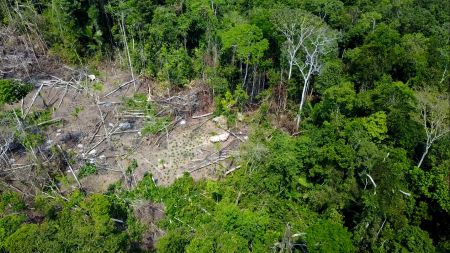
Unseen images, captured by a drone near the border between Brazil and Peru, reveal the existence of a new isolated tribe, discovered by the Indian National Foundation.
Some people walking in a clearing in the middle of the abundant vegetation. Photos published by Funai also show canoes, an ax and a thatch hut. 
The video was shot in 2017, but released this week.
It is part of the images collected by Funai during several expeditions in the Javari Valley, an area very difficult to access in the south-east of Amazonas.
The expedition has traveled more than 180 kilometers by boat, truck or motorbike, and 120 kilometers on foot in the dense forest to reach the region.
It is a Brazilian state (south-east) where the majority of the evidence of existence of isolated peoples in the country was gathered with the discovery of clues such as a huge hut, homemade axes, a bugle made with bark or canoes dug into palm tree trunks.
 Eight indigenous tribes in the region have already come into contact with the outside world, according to Funai, while at least eleven others still live in autarky. Eight indigenous tribes in the region have already come into contact with the outside world, according to Funai, while at least eleven others still live in autarky.
The institute obtained these images during a mission to protect isolated Indians, the third "in less than a year in this region," said his statement.
The expedition relies on the help of members of the Kanamari people, connoisseurs of the region.
It also recorded not only "the assiduous presence of hunters" but also the encroachment of landowners in these Indian-only territories.
She met two teams of poachers on her way and forced them to release the captured animals alive.
"Vigilance and control need to be intensified in the region to prevent delinquent action and to ensure the entire indigenous ownership of the territory , " said Vitor Góis, the project coordinator.
|
|
|
|
|
|
|
|
| Carl Delsey for DayNewsWorld |
 |
ERRUPTION OF THE KILAUE VOLCANO
|
|

Kilauea is one of the most active volcanoes in the world and one of Hawaii's five, the largest in the archipelago.
The lava flows into the ocean near Pahoaet causing acid fumes.
According to Hawaii authorities, the arrival in the Pacific Ocean of lava from Kilauea volcano, erupted May 3, causes a dangerous chemical phenomenon.
Two lava flows "hit the ocean on the southeast coast of Puna" on the Big Island of Hawaii, according to a statement released Sunday by the US Institute of Geological Survey (USGS).
An open crack in the ground, however, "diverted the lava [...] in underground cavities , " says the USGS release.
The meeting of incandescent lava and water produces acid fumes, a phenomenon referred to in English as laze, a word formed from lava (lava) and haze (fog).
"The plume is an irritating mixture of hydrochloric acid (HCl), steam and small particles of volcanic glass, according to the USGS. This hot, corrosive gaseous mixture caused two deaths in the immediate vicinity of the coastal steam entry point and small volcanic glass particles, according to the USGS. This hot, corrosive gaseous mixture caused two deaths in the immediate vicinity of the coastal entry point in 2000, when the sea hit recent and active lava flows. "
Due to moderate winds, leeward areas "may experiment with various levels of vog [volcanic smog]" , volcanic fog created by the reaction of emissions to oxygen, moisture, dust, and sunlight , according to the USGS.
Its eruption on May 3 has already forced some 2,000 people to evacuate their homes.
Scientists believe that volcanic activity is perhaps heralding a major eruption similar to that of the mid-1920s.
|
|
|
|
|
|
|
|
| Carl Delsey for DayNewsWorld |
 |
There are no translations available.
PHARAONIQUE PROJET NEOM EN ARABIE SAOUDITE
|
|
 Face à la perspective de la fin du tout pétrole, l’Arabie saoudite s'est engagée dans une grande réorientation de son économie, dans une vaste diversification pour ne plus dépendre que de l'or noir. Ce pays n'hésite pas à s'emparer des technologies le plus innovantes pour investir à coup de milliards de dollars dans des projets pharaoniques..La mégapole Neom: tout y sera moderne et innovant selon le projet présenté sur le site Discoverneom.com. Face à la perspective de la fin du tout pétrole, l’Arabie saoudite s'est engagée dans une grande réorientation de son économie, dans une vaste diversification pour ne plus dépendre que de l'or noir. Ce pays n'hésite pas à s'emparer des technologies le plus innovantes pour investir à coup de milliards de dollars dans des projets pharaoniques..La mégapole Neom: tout y sera moderne et innovant selon le projet présenté sur le site Discoverneom.com.
Le prince héritier saoudien Mohammed ben Salmane Al Saoud a de grands projets pour la ville futuriste qu'il compte faire construire au bord de la Mer rouge au nord-ouest du pays dans une zone pour le moment désertique. "Seuls les rêveurs sont les bienvenus", proclame Mohammed ben Salmane, prince héritier d'Arabie saoudite en dévoilant son projet pharaonique .
Baptisée Neom (ou Neo-Mostaqbal qui signifie « nouveau futur »), cette mégapole promet d'embrasser les dernières technologies en matière d'énergies renouvelables, d'architectures et de transports. Un projet de pas moins de 500 milliards de dollars...
A terme cette vaste zone de développement économique de 26.500 km² devrait s'étendre aux rives de l'Égypte et de la Jordanie sur 460 kilomètres de côtes dans le golfe d'Aqaba.
Cette mégapole du futur entend aussi révolutionner l'alimentation de ses citoyens grâce à l'agriculture verticale, le développement de cultures en zones arides et en eau de mer ainsi que l'utilisation de serres photovoltaïques.
La mégapole utilisera massivement les énergies renouvelables, avec des fermes éoliennes et photovoltaïques et des systèmes de stockage d'énergie à grande échelle. Un programme de dessalement de l'eau de mer sera développé. Neom sera dotée du plus grand jardin installé au cœur d'une métropole, d'un mode d'agriculture vertical, de cultures en zones arides et en eau de mer. Pour les transports centrale dans ce projet on peut s' attendre à solutions autonomes et écologiques. Bien qu'aucun détail n'ait encore été divulgué à ce sujet, les voitures et transports en commun autonomes et les drones taxis sont cités en bonne place.
Pourquoi construire une telle mégalopole ?
La création de cette mégapole futuriste exemplaire d’un point de vue environnemental doit devenir attractive pour les secteurs économiques de pointe et participe de la volonté de diversification pour ne plus dépendre seulement de l'or noir..
Concrètement Neom sera appelé à être une zone de développement économique dotée d'une législation et d'une fiscalité spécifiques pour favoriser les investissements et attirer les compétences humaines. Les secteurs-clés de la science sont ciblés non seulement les biotechnologies- « Le monde se tournera vers Neom pour la prochaine génération de thérapie génique, la génomique, la recherche sur les cellules souches, la nano-biologie et la bio-ingénierie », peut-on lire sur le site promotionnel- mais aussi les domaines de l'Internet des objets, de l'impression 3D, de la robotique, des nanotechnologies mais aussi de l'industrie des loisirs
La première phase du projet Neom devrait s'achever en 2025. En 2030, ses promoteurs prédisent que la ville contribuera à hauteur de 100 milliards de dollars à l'économie saoudienne
Le prince héritier saoudien ambitionne donc de construire une mégalopole à la pointe de la technologie au bord de la Mer rouge pour y développer un "mode de vie idyllique combiné à d'exceptionnelles perspectives économiques".
Dans la vidéo promotionnelle de cette ville du futur, on voit des femmes vêtues à l'occidental qui travaillent à côté d'hommes. Une révolution qui répond aux vœux du prince héritier, chantre d'une nouvelle Arabie saoudite "modérée et ouverte", en rupture avec l'ultraconservatisme religieux.
|
|
|
|
| Paul Emison pour DayNewsWorld |
 |
LIE CLIMATIC HEATING
TO HUMAN ACTIVITIES OR
WIDE SMOOTHING OF COP 21 ?
|
The affirmation of Marcel Leroux, eminent climatologist  can appeal to more than one citizen at the time of the big COP21 summit in Paris. The latter had stated bluntly can appeal to more than one citizen at the time of the big COP21 summit in Paris. The latter had stated bluntly
that there was' no causal relationship, physically based, proven and quantified (...) established between the evolution of temperature (rise, but also decline) and the variation of the greenhouse effect by CO2.
A fortiori, no relationship is demonstrated between human activities and the climate: the man is in no way responsible for climate change. "(NRH, 2007, n ° 31).
Moreover, the fluctuations of the climate have always marked the long history of humanity, passing from more or less icy periods to more or less temperate periods.
How then to understand this high mass of 176 countries gathered in Paris - at great cost to the French taxpayer - trying to find an agreement against global warming linked to human activities?
For all these countries, it would be necessary to reduce the concentrations of CO2 in the atmosphere, as well as those of some other greenhouse gases - methane (CH4), nitrous oxide (N2O), and CFC- due to man, guilty that they would be warming our planet ...
It is that an intergovernmental panel on climate change (the IPCC) was created by the United Nations in 1988. It has concocted a synthesis of various
scientific studies on this issue. His latest and fourth report, based on more than 2,500 scientists from 130 countries, concludes that global warming since 1950 is most likely due to the rise in anthropogenic greenhouse gases.
In addition, a study published late 2012 has assembled and compared simulations from 20 different computer models in this direction. These climate modulations added to information from satellite observations by a team of US climatologists would have led to the conclusion that human activities were at the origin of the change in the temperature of the troposphere and the stratosphere. 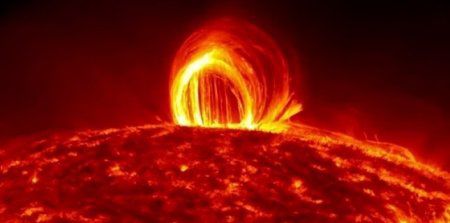
This is without counting with unquestionable scientific data:
-the oceans produce 80 gigatonnes of CO2, the vegetation 13 while humans produce only 7. A drop of water in the ocean.
-the sun is the most important source of heat. The flow of radiation from the Sun - mainly visible light and near-infrared radiation - heats the Earth. The climate depends on it.
-While even assuming that the global surface temperature is likely to increase by an additional 1.6 ° to 4 ° C in the 21st century, as climate model projections would seem to predict, it remains that the tiny part of man's production of carbon dioxide hardly interferes with global warming. The man would come to disappear that our planet would warm anyway!
Of course we can not question the general climate change. The latter is already noticeable in extreme weather events. Our planet suffers more and more heat waves, droughts, floods due to exceptional floods, tornadoes ... Global warming will accelerate, but it does not have a human origin. Even more disconcerting the existence of periods of glaciation with a high rate of CO2 when man did not exist!
Consequently, there is no need to make men feel too guilty.
Moreover, the only controversy over the melting of the Kilimanjaro glacier that lost 82% of its glacier during the twentieth century and could disappear in 2020 poses the problem of the impartiality of IPCC analyzes.
Indeed, what are the real causes of the retreat of the Kilimanjaro glacier in Africa? 
Some climate scientists attribute it to a decrease in snowfall since the 19th century, while others believe that the ice of Kilimanjaro having withstood a long drought 4000 years ago is melting because of global warming.
"It is premature to say that Himalayan glaciers are backing up abnormally due to global warming. A glacier is influenced by a variety of physical factors and a complex interconnection of climatic factors. "Says a recognized scientist.
In addition, an error concerning the date of melting of the Himalayan glaciers in the 900-page IPCC 2007 report knowingly retained when it was reported by a member of the Institute of Glaciology in 2006 discredited the respect of the validation procedures.
Climate-skeptics shouted at the manipulation of numbers. The broad scientific consensus has collapsed.
Why demonize at this point global warming?
There is no doubt that it is a question of making adherence by all means and, even passing by the caricature and the demonization, the populations. The Machiavellianism of rulers, ecologists and unscrupulous industrialists is certainly part of this logic.
So the question is who benefits from the crime?
New industries using new technologies such as wind power, solar energy, biofuels, electric cars, carbon sequestration, etc. are being developed as a result of IPCC alarm sirens; Protocols have been accepted by many countries, such as the Rio Protocol in 1992 and the Kyoto Protocol in 1997. As a result, the world's economy, which is essentially based on oil and other fossil fuels, is fiercely competing with these new clean energy technologies. . This causes significant political tensions and conflicts of interest.
No wonder that global warming is becoming the stumbling block between industrialists with conflicting interests and between different countries of the world. 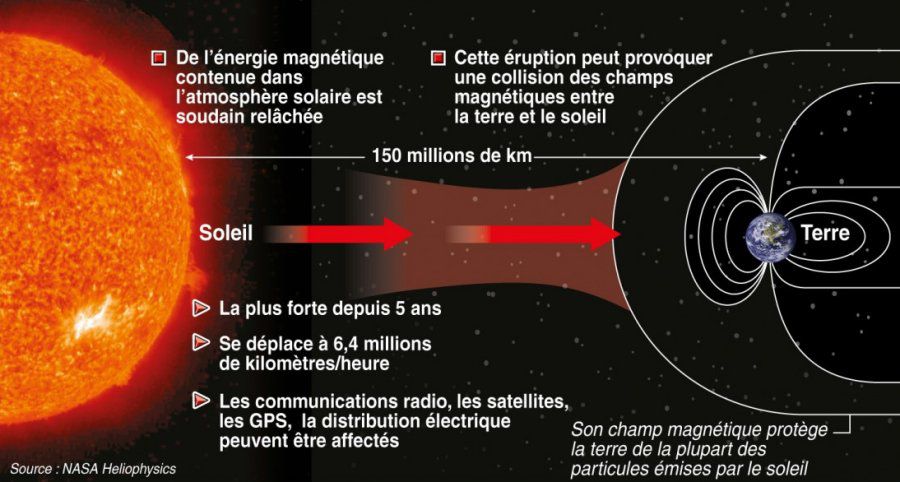
In addition to new industries using new technologies to avoid emitting greenhouse gases, the nuclear industry that evokes a production of "clean" electricity is doing well. As for the oil industries, they handle the double language .
What about different nations?
It is also the division and the confrontation which lead the debates on the question of the global warming. Indeed if, in the concert of the nations, no one does not really dispute the physical laws involved in the global warming, the reduction of the Greenhouse gas in human activities is not self-evident.
This is because the interests of different countries do not necessarily converge.
The United States emits 25% of greenhouse gases. China emits the same percentage, but represents a reduced rate of emission if it is reduced to the number of inhabitants.
Globally, the richest countries are minority in number of inhabitants, but emit more greenhouse gases than the emerging countries and the most disadvantaged countries. Nevertheless the ratio (CO2 / $ of GDP) is very variable, some developed countries are relatively efficient (Japan, France, Switzerland, Nordic countries) and others rather average (United States for example) whereas much less developed countries emit a lot of CO2 (ex-USSR in particular). These data show that economic growth does not necessarily lead to an increase in releases and that there is significant room for improvement in many countries, without affecting the comfort of life of the inhabitants.
Nations are divided over policies to limit greenhouse gas emissions. The European Union is generally in favor of the fight against global warming, with the notable exception of the Czech Republic and its President Vaclav Klaus, the United States, Australia, India have long been reluctant judging these costly and insufficiently scientifically sound limitation policies. Russia, Canada, China were until then the least enthusiastic.
Certainly the COP21 ...
Even if this is the case, is it reasonable to stop the current efforts of the international community to reduce CO2 emissions into the atmosphere by giving in to pressure from lobbies, oil companies and others?
There is no doubt that the explosion in the price of a barrel of oil has played an important role in the willingness of states to reduce CO2 emissions. A virtuous circle indeed appears: by consuming less, one reduces both the energy bill and the contribution to global warming. This purely physical phenomenon that is actually global warming is presented as a curse punishing men guilty of succumbing to the sirens of energy overconsumption. Ecologists to exploit global warming for their theses on the reduction of economic growth. The increase in the temperature of the globe, however, does not have the same consequences for everyone. This phenomenon does not affect the entire planet in the same way. So we can ask ourselves who benefits from the crime? Are we able, today, to anticipate the consequences of global warming on the different parts of the globe? Melting ice, while it can be dramatic for polar bears, also opens trade routes for some countries ...
And what about the spectacular conversion of François Hollande to the climatic cause. Sincere awareness?
Political maneuver to mend with the ecologists?
The recent news, from Notre-Dame-des-Landes to Sivens via the suspension of the ecotax, is perplexing.
Declarations and initiatives succeed one another: the forthcoming elimination of coal subsidies in aid to developing countries, a promised intervention in Brussels to put an end, in the long term, to European aid for fossil fuels and for an orientation of the plan. Juncker for green growth and the energy transition. Not to mention the famous paragraph on climate obtained by France in the final declaration of the last G20 summit.
Mistrust .
|
|
|
|
|
|
|
| Larry Ricky for DayNewsWorld. |
|

|
|
|